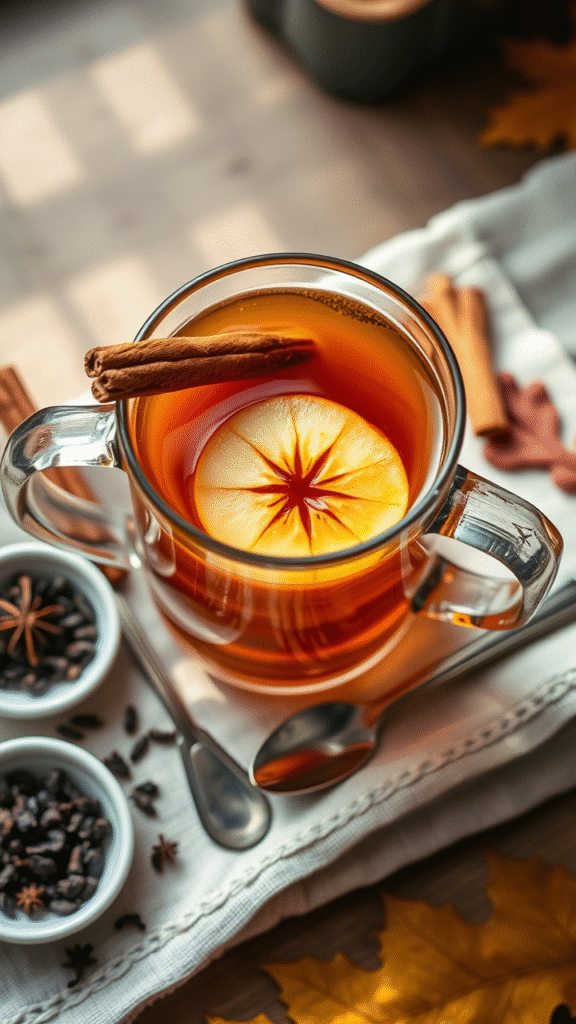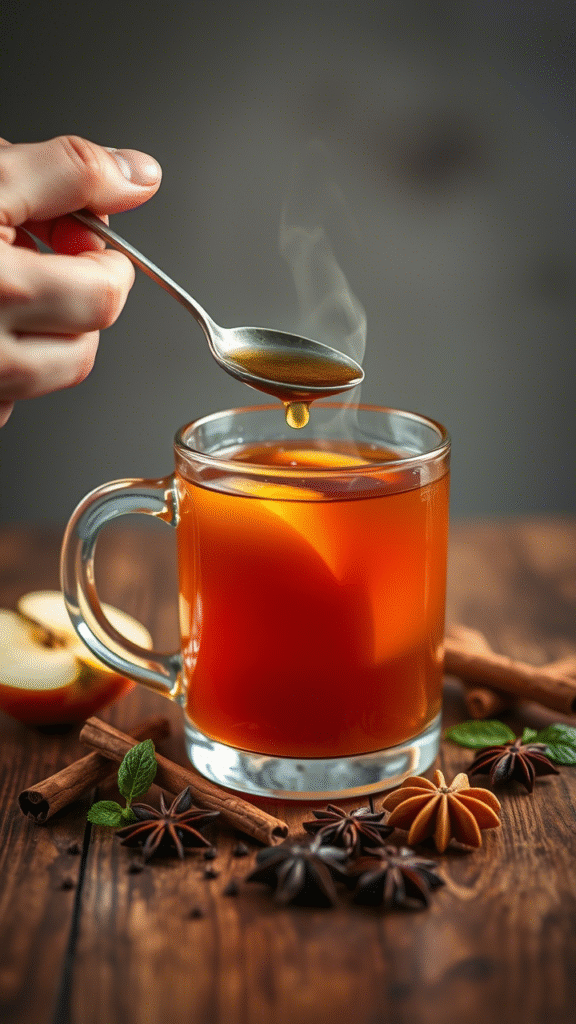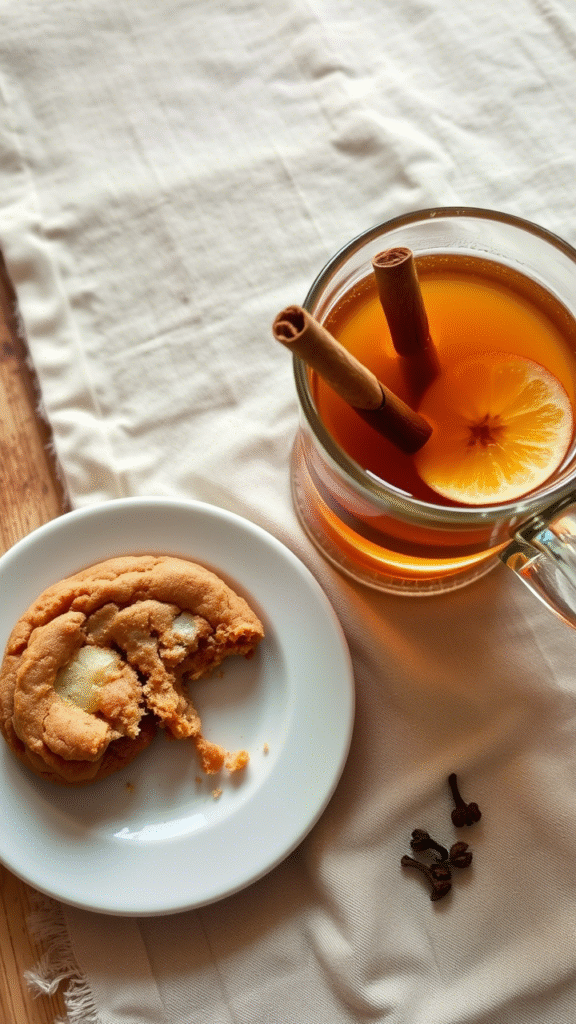It was early October, crisp wind running like a whisper through half-yellow trees, when I first tasted real spiced apple cider tea. Not the syrupy stuff they hand you at winter markets—this was steeped, not poured. A brew pulled together with spice, fruit, and time. It smelled like the inside of a pie and tasted like a secret passed down generations. It wasn’t in any book. An old woman at a farmer’s market handed me a steaming mason jar with a cracked lid and said, “Don’t gulp it. Let it tell you somethin’.”
I’ve been chasing that brew ever since.
Spiced Apple Cider Tea isn’t quite tea and not exactly cider either. It balances on a line between comfort drink and potion. It’s not only for sipping on cold evenings—though that’s when it sings—it’s also used by some as a base for cocktails, a morning energizer, or even a kitchen aroma that announces, we’re home now. There’s history in its spices, function in its steeping, and if you make it properly, it’ll hug your chest from the inside out.
This recipe is deeply special. Why? Because it invites improvisation without punishment. Because it uses the whole spice—no shortcuts here. Because it’s equally at home in a fine-dining kitchen or over a campfire with a rusty kettle. And because when done right, it’s medicine masquerading as indulgence.
Ingredients & Substitutions

Let’s start at the root of the brew. These aren’t just “ingredients”—they’re characters in a story.
- Fresh apples (3-4 medium, sweet-tart like Honeycrisp or Pink Lady)
→ Don’t grab the bruised bagged ones. You want bright skin and tight flesh. If apples were personalities, these ones should flirt back when you pick them up. - Filtered water (6 cups)
→ Don’t use tap if it smells like a swimming pool. Water is your base. Respect it. - Cinnamon sticks (2-3 whole)
→ Fresh sticks, not dusty shavings from 2007. You’ll smell the difference. - Whole cloves (6-8)
→ Little flavor bombs. Go easy—they’re strong like your grandmother’s scolding voice. - Star anise (2 pods)
→ Optional, but gives a slightly licoricey backbone. Adds depth. - Fresh ginger (1-inch knob, sliced thin)
→ Not powdered. Never powdered. Slice it thin like you’re trying to read through it. - Black tea bags (2, preferably Assam or Darjeeling)
→ Adds that bitter tannic spine. Skip if you want a caffeine-free version. - Maple syrup or honey (2-3 tablespoons)
→ Adjust to taste. Don’t use white sugar—it bulldozes the flavor profile. - Orange peel (from 1 small orange, no pith)
→ Brings a bright, citrusy top note. Pith is bitter, like regret. Avoid it. - Nutmeg (a few grates of fresh, if possible)
→ Adds warmth. Pre-ground is fine, but fresh will sing.
Substitutions:
- Allergic to ginger? Try cardamom pods instead.
- No black tea? Rooibos works for a caffeine-free twist, with a naturally sweet earthiness.
- Vegan? Stick with maple syrup instead of honey.
- Can’t find star anise? Skip it. Or replace with a pinch of fennel seeds for a lighter lift.
Quality matters. Use spices that haven’t been sitting in the back of your pantry since Obama’s first term.
Step-by-Step Instructions

This ain’t a pour-and-go affair. It’s about layering flavors patiently.
- Core and chop your apples. No need to peel. Toss them in a pot with the water.
- Pro tip: Slice them thin for quicker flavor extraction. Thicker chunks look prettier but work slower.
- Add cinnamon, cloves, ginger, star anise, nutmeg, and orange peel.
- Tip: Tie your spices in cheesecloth for easy straining later. Or don’t. Just mind the cloves in your mug—they bite.
- Bring to a gentle boil, then reduce to simmer for 20-25 minutes.
- Don’t let it roll too hard. A harsh boil muddies the flavors and beats up the fruit.
- Add the black tea bags during the last 5 minutes of simmering.
- Oversteeping tea makes it bitter, not stronger. Like arguments past midnight.
- Remove from heat. Let it steep another 5-10 minutes off the flame.
- Let the brew think about what it’s become.
- Strain the liquid into a teapot or jug.
- Press the apples gently with a spoon to release their juice, but don’t mash. This ain’t applesauce.
- Stir in honey or maple syrup while still warm. Taste. Adjust.
- Start with less sweetener than you think. Let the apples lead.
- Serve hot in mugs, or chill and serve over ice.
- Hot is traditional. Cold is sneaky good, especially with a shot of bourbon.
Mistakes to avoid:
- Don’t boil the tea bags. Tannins go rogue.
- Don’t skip fresh ingredients unless you want something flat and forgettable.
- Over-sweetening is common. Let it breathe before deciding it needs more sugar.
Cooking Techniques & Science
Now, let’s nerd out a bit.
Simmering whole spices unlocks volatile oils. These aren’t just for flavor—they interact with your senses at a neurological level. Cinnamon warms you, ginger wakes you, clove numbs the tongue slightly, and orange peel cuts through the fat (even if there’s no fat in the drink—it’s just how our brains read it).
Using whole apples, not juice, changes everything. You get pectin. Pectin gives mouthfeel. Juice gives sugar.
Black tea introduces polyphenols—those bitter compounds that balance the sweetness and add structure. Think of it like tannins in wine: they give shape to the taste.
And the brew time? You’re not just cooking—you’re steeping. The longer the spices sit, the deeper the flavor. But let it go too long and the bitterness creeps in like an uninvited guest who doesn’t take hints.
Tools that help:
- A non-reactive pot (like stainless steel or enameled cast iron). Aluminum can leach metallic notes.
- Cheesecloth or a fine mesh strainer.
- A ladle that pours clean—trust me, it matters more than you think.
Serving & Pairing Suggestions

Presentation is mood-setting. Use glass mugs if you want to show off that golden amber color. A cinnamon stick stirrer? Cute, but also functional—it releases more aroma.
Pairings:
- A slice of spiced carrot cake.
- A cheese board with aged cheddar and dried figs.
- Sweet potato scones with a pat of salted butter.
- Dark chocolate. Just trust me.
This brew can go solo, but it loves company.
Want to go grown-up? Splash in a touch of dark rum or apple brandy. You just turned your tea into a firelight cocktail.
Conclusion
Spiced Apple Cider Tea isn’t just a recipe. It’s an experience. A memory in the making. It’s one of those drinks that makes you slow down without trying to. If made right, it becomes part of your cold-weather ritual.
Every component plays its part. Skip nothing, but tweak everything. That’s the beauty of it.
Final expert tip? Always make extra. This stuff disappears quicker than you think. And refrigerates like a dream—up to five days. Warm gently, never microwave if you can help it. Let it reawaken on the stove.
FAQs
1. Can I make Spiced Apple Cider Tea in advance?
Yes, in fact, it tastes better the next day. Store it in the fridge and reheat gently on the stove.
2. Can I use ground spices instead of whole?
Technically yes, but you’ll get murkier flavor and grit in the cup. Stick with whole when you can.
3. Is there a caffeine-free version?
Absolutely. Just skip the black tea or replace with rooibos or chamomile.
4. Can I make this in a slow cooker?
Yes! Combine all ingredients and cook on low for 2-3 hours. Add tea bags in the last 20 minutes.
5. What kind of apples work best?
Go for a mix. A tart one like Granny Smith and a sweet one like Fuji creates better balance.

Food lover, recipe creator & the heart behind NoshCrafters.com. Olivia shares mouthwatering, easy-to-make dishes that turn everyday meals into unforgettable bites. When she’s not experimenting in the kitchen, she’s busy plating up inspiration for home cooks everywhere.